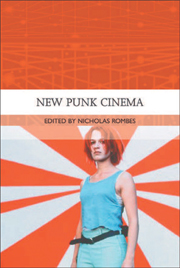Book contents
- Frontmatter
- Contents
- Notes on the Contributors
- Acknowledgements
- Introduction
- PART I BACKGROUNDS AND CONTEXTS
- PART II SCREENING NEW PUNK CINEMA
- 5 DVD and the New Cinema of Complexity
- 6 Digital Technologies and the Poetics of Performance
- 7 Navigating Chaos
- 8 Non-linear Narrative
- 9 Making it Real
- PART III CASE STUDIES
- Bibliography
- Index
8 - Non-linear Narrative
from PART II - SCREENING NEW PUNK CINEMA
Published online by Cambridge University Press: 05 August 2013
- Frontmatter
- Contents
- Notes on the Contributors
- Acknowledgements
- Introduction
- PART I BACKGROUNDS AND CONTEXTS
- PART II SCREENING NEW PUNK CINEMA
- 5 DVD and the New Cinema of Complexity
- 6 Digital Technologies and the Poetics of Performance
- 7 Navigating Chaos
- 8 Non-linear Narrative
- 9 Making it Real
- PART III CASE STUDIES
- Bibliography
- Index
Summary
The Golden Age of Hollywood
Charting a revision of – or diversion from – a particular kind of cinema presumes that cinematic trends are coherent and that such trends can be identified through a series of texts, authors and what can loosely be defined as distributors. This is often less instructive than it initially appears, and can sometimes lead to broad and occasionally meaningless generalisations. Contemporary critical writing, however, distinguishes classical narrative cinema as the zenith of the Hollywood studio film of the 1930s, ‘40s and ‘50s, exemplified in the work of Frank Capra (Mr Smith Goes to Washington [1939], It's a Wonderful Life [1946]), Howard Hawks (Scarface [1932], The Maltese Falcon [1940]) and John Ford (Stagecoach [1939], The Grapes of Wrath [1940], The Searchers [1956]). Though directors such as Orson Welles and Alfred Hitchcock had produced films that constituted a departure from the classical model (Welles's Citizen Kane [1940]) and Hitchcock's Rope [1948] spring to mind as deliberate attempts at formal innovation), the studio film thrived on the founding principles of an often reworked and imminently recognisable formula. I use the phrase ‘founding principles’ to avoid the oversimplified (and yet perennial) notion that a single homogeneous film structure constituted an entire cinematic tradition, which is clearly not the case. This essay will not take the position that the studio film offered one product in a variety of disguises. It was rather a rich and complex body of texts (reflecting numerous aesthetic traditions) that informs a contemporary American cinema as much as it offers a vital point of departure.
- Type
- Chapter
- Information
- New Punk Cinema , pp. 126 - 138Publisher: Edinburgh University PressPrint publication year: 2005



